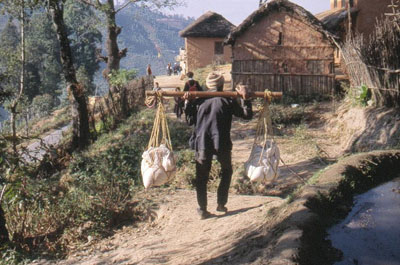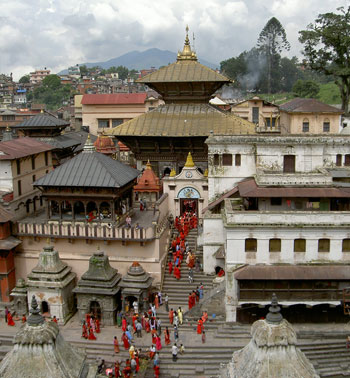Nepal
Country statistics

Land area: 52,819 sq miles (136,801 sq km)
Total area: 54,363 sq miles (140,800 sq km)
Population (2010 est.): 28,951,852 (growth rate: 1.4%); birth rate: 22.4/1000; infant mortality rate: 46.0/1000; life expectancy: 65.8; density per sq km: 206
Capital City: Kathmandu
Monetary unit: Nepalese rupee
Languages: Nepali 90% (official), over 40 other languages and major dialects, English (1995)
Ethnicity/race: Brahmin, Chetri, Newar, Gurung, Magar, Tamang, Rai, Limbu, Sherpa, Tharu, and others (1995)
Religions: Hindu 86.2%, Buddhist 7.8%, Islam 3.8%, other 2.2% (1995)
Country introduction

Nepal is a landlocked country located in South Asia. It is located in the Himalayas and bordered to the north by China, and to the south, east, and west by India. Specifically, the Indian states of Uttarakhand, Uttar Pradesh, Bihar, West Bengal, and Sikkim border Nepal, while across the Himalayas lies the Tibetan Autonomous Region, that has freedom from an external authority. Although Nepal shares no boundary with Bangladesh, the two countries are separated by a narrow strip of land about 24 km (15 miles) wide, known as the Chicken's Neck. Efforts are underway to try and make this area a free-trade zone.
Nepal is commonly divided into three geographic areas, which are the Mountain, Hill, and Terai Regions. These ecological belts run east-west and are bisected by Nepal's major river systems.
The Terai Plains, bordering India are part of the northern rim of the Indo-Gangetic plains, were formed and are fed by three major rivers: the Kosi, the Narayani (India's Gandak River), and the Karnali. This region has a hot, humid climate.
The Hill Region (Pahar in Nepali) protrudes the mountains and varies between 1,000 and 4,000 m (3,280 - 13,123 ft) in altitude. Two low mountain ranges, the Mahabharat Lekh and Shiwalik Range (also known as the Churia Range) dominate the region. The hilly belt includes the Kathmandu Valley, the country's most fertile and urbanised area.
Eight of the top ten highest mountains in the world are located in Nepal. Kanchenjunga, the world's third highest peak is also located on its eastern border with Sikkim. Deforestation is a major problem in all regions, with resulting erosion and degradation of ecosystems.
The culture

Similarities of culture can be observed in the clothing, way of life, language and food to the south and Tibetan to the north. A typical Nepalese meal is dal-bhat, boiled lentils served with rice and usually vegetables. This is consumed twice daily, once in the morning and again after sunset. Between these main meals, snacks such as chiura (beaten rice) and tea are consumed. Meat, eggs, and fish are also consumed, particularly in the mountainous regions, where the diet tends to be richer in protein. Millet-based alcoholic drinks are popular, including jaad and the distilled rakshi.
Folklore is an integral part of Nepalese society. Traditional stories are rooted in the reality of day-to-day life-tales of love, affection, battles, and demons and ghosts; they reflect and explain local lifestyles, cultures and belief systems. Many Nepalese folktales are enacted in dance and music. The Newar people are well-known for masked dances that tell stories of the gods and heroes. Music is percussion-based, sometimes with flutes or shawm accompanying the intense, nasal vocal lines.
Attractions & landmarks

Nepal is the country where Mount Everest, the highest mountain peak in the world, is located. Mountaineering and other types of adventure tourism and are important attractions for visitors. The world heritage Lumbini, birthplace of Gautama Buddha, is located in Southern Nepal, and there are other important religious pilgrimage sites throughout the country.
An example of a religious site is the Pashupatinath Temple, with its astonishing architectural beauty, stands as a symbol of faith, religion, culture and tradition. Regarded as the most sacred temple of Hindu Lord Shiva in the world, Pashupatinath Temple's existence dates back to 400 A.D. The richly-ornamented pagoda houses the sacred linga or phallic symbol of Lord Shiva. Thousands of pilgrims from all over the world come to pay homage to this temple, that is also known as 'The Temple of Living Beings'.
Another well-known pilgrimage site is the Buddhist Bouddhanath Stupa, the biggest stupa in Nepal which lies about 7 km (4 miles) east of the capital. It is also called by many as Khasti Chitya and is one of the oldest stupas in the country. After 1959, many Tibetans arrived and settled in Bouddhanath area.
Kathmandu Durbar Square is rich in history and is clustered with ancient temples, palaces, courtyards and streets that date back to the 12th and 18th centuries. The square is known to be the social, religious and urban focal point of the Capital City.
Major tourist activities include wilderness and adventure activities such as mountain biking, bungy Jumping, rock climbing and mountain climbing, trekking, bird watching, flights, paragliding and hot air ballooning over the mountains of Himalaya, exploring the waterways by raft, kayak or canoe and jungle safaris especially in the Terai region.
The Royal Chitwan National Park is a great place to visit to hear the wild roars of tigers, chirping of jungle birds, the feel of soothing breeze and the splashing ripples of the river Rapti.